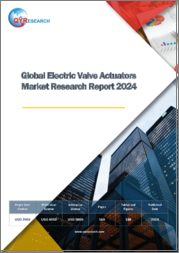
|
시장보고서
상품코드
1617838
세계의 산업용 밸브 액추에이터 시장 : 제품, 시스템, 최종 사용자별 예측(2025-2030년)Industrial Valve Actuators Market by Product (Industrial Actuators, Industrial Valves), System (Electric, Hydraulic, Mechanical), End-User - Global Forecast 2025-2030 |
||||||
산업용 밸브 액추에이터 시장의 2023년 시장 규모는 1,185억 9,000만 달러로 평가되었습니다. 2024년에는 1,266억 달러로 평가되었고, 복합 연간 성장률(CAGR) 7.04%로 성장하여 2030년에는 1,909억 7,000만 달러에 달할 것으로 예측됩니다.
산업용 밸브 액추에이터 시장의 범위는 석유 및 가스, 물, 화학제품 등의 산업용 파이프라인 내의 유체의 흐름을 조정, 제어하는 자동화 시스템을 폭넓게 망라하고 있습니다. 변환하는 장치로 정의되는 이러한 액추에이터는 다양한 산업에서 효율, 정확성 및 안전성을 달성하는 데 필수적입니다.?가스, 수처리, 발전, 화학처리, 광업 등의 부문에 걸치는 중요한 용도으로, 복잡한 시스템에 있어서의 신뢰성이 높은 유량 제어의 필요성에 의해 강조되고 있습니다. 방향 제어를 정확하게 제어하고 운전 효율을 높이고 가동 중지 시간을 줄일 수 있으므로 이러한 부문에서 필수적입니다.
| 주요 시장 통계 | |
|---|---|
| 기준년 (2023년) | 1,185억 9,000만 달러 |
| 추정년 (2024년) | 1,266억 달러 |
| 예측년(2030년) | 1,909억 7,000만 달러 |
| 복합 연간 성장률(CAGR)(%) | 7.04% |
주요 성장 요인으로는 산업화에 의한 자동화 시스템에 대한 수요 증가와 견고한 유량 관리 솔루션이 필요한 재생 가능 에너지원으로의 시프트 등을 들 수 있습니다. 실시간 데이터 분석, 예지 보전, 원격 조작을 가능하게 함으로써 시장 성장의 큰 기회도 사업 효율성 향상과 비용 절감을 요구하는 기업에 어필하고 있습니다. 그러나 초기 도입 비용의 높이, 엄격한 환경 규제, 저비용 제조업체와의 격렬한 경쟁 등의 요인이 시장 성장의 과제가 되고 있습니다 게다가 기존 시스템 내에서의 새로운 기술의 통합에 관한 기술적 문제가 심리스 채용의 장벽이 될 가능성도 있습니다.
혁신과 연구는 사이버 보안 보호 및 다양한 산업용 인터넷 용도과의 호환성 강화와 같은 고급 기능을 갖춘 비용 효율적이고 환경 친화적 인 액추에이터 개발에 중점을 두어야합니다. 중시하고, 내마모성이 뛰어난 재료를 채용하는 것도, 경쟁상의 우위성을 가져오면 시장은 본질적으로 역동적이며 지속적인 기술 혁신이 요구됩니다. 활용하고 진화하는 산업 수요에 대응하기 위해서는 스마트 기술과 전략적 파트너십에 대한 투자를 우선해야 합니다.
시장 역학 : 빠르게 진화하는 산업용 밸브 액추에이터 시장의 주요 시장 인사이트 공개
산업용 밸브 액추에이터 시장은 수요 및 공급의 역동적 인 상호 작용으로 변화를 겪고 있습니다. 세련되고 새로운 비즈니스 기회를 얻는 데 도움이 됩니다. 이러한 동향을 종합적으로 파악함으로써 기업은 정치적, 지리적, 기술적, 사회적, 경제적 영역에 걸친 다양한 위험을 완화할 수 있으며, 소비자 행동과 그것이 제조 비용과 구매 동향에 미치는 영향을 더욱 명확하게 이해할 수 있습니다.
- 시장 성장 촉진요인
- 산업 플랜트에 있어서의 IIoT에 대한 주목의 고조에 수반하는 급속한 산업화
- 석유 및 가스 산업에 있어서의 산업용 밸브 액추에이터의 사용 증가
- 의료 및 제약 산업에 있어서의 산업용 밸브 수요 증가
- 시장 성장 억제요인
- 산업용 밸브 액추에이터의 초기 도입 비용과 유지 보수 비용의 높이
- 시장 기회
- 산업용 밸브 액추에이터 개발에 있어서의 기술 진보의 고조
- 상하수도 처리 프로젝트 개발에 대한 투자 증가
- 시장의 과제
- 산업용 밸브 액추에이터의 사용에 관한 기술적 문제
Porter's Five Forces : 산업용 밸브 액추에이터 시장을 탐색하는 전략 도구
Porter's Five Forces Framework는 산업용 밸브 액추에이터 시장 경쟁 구도를 이해하는 중요한 도구입니다. Porter's Five Forces Framework는 기업의 경쟁력을 평가하고 전략적 기회를 탐구하는 명확한 기술을 제공합니다. 이 프레임워크는 기업이 시장 내 세력도를 평가하고 신규 사업의 수익성을 판단하는 데 도움이 됩니다. 이러한 인사이트을 통해 기업은 자사의 강점을 활용하고 약점을 해결하고 잠재적인 과제를 피함으로써 보다 강인한 시장에서의 포지셔닝을 확보할 수 있습니다.
PESTLE 분석 : 산업용 밸브 액추에이터 시장에서 외부 영향을 파악
외부 거시 환경 요인은 산업용 밸브 액추에이터 시장의 성과 역학을 형성하는 데 매우 중요한 역할을합니다. 정치적, 경제적, 사회적, 기술적, 법적, 환경적 요인 분석은 이러한 영향을 탐색하는 데 필요한 정보를 제공합니다. PESTLE 요인을 조사함으로써 기업은 잠재적인 위험과 기회를 더 잘 이해할 수 있습니다. 이 분석을 통해 기업은 규제, 소비자 선호, 경제 동향의 변화를 예측하고 앞으로 예상되는 적극적인 의사 결정을 할 준비가 가능합니다.
시장 점유율 분석 : 산업용 밸브 액추에이터 시장에서 경쟁 구도 파악
산업용 밸브 액추에이터 시장의 상세한 시장 점유율 분석을 통해 공급업체의 성과를 종합적으로 평가할 수 있습니다. 기업은 수익, 고객 기반, 성장률 등 주요 지표를 비교하여 경쟁 포지셔닝을 밝힐 수 있습니다. 이 분석을 통해 시장 집중, 단편화, 통합 동향을 밝혀내고 벤더들은 경쟁이 치열해지는 가운데 자사의 지위를 높이는 전략적 의사 결정을 내리는 데 필요한 지식을 얻을 수 있습니다.
FPNV 포지셔닝 매트릭스 : 산업용 밸브 액추에이터 시장에서 공급업체의 성능 평가
FPNV 포지셔닝 매트릭스는 산업용 밸브 액추에이터 시장에서 벤더를 평가하는 중요한 도구입니다. 이 행렬을 통해 비즈니스 조직은 공급업체의 비즈니스 전략과 제품 만족도를 기준으로 평가하여 목표에 맞는 충분한 정보를 바탕으로 의사 결정을 내릴 수 있습니다. 네 가지 사분면을 통해 공급업체를 명확하고 정확하게 세분화하여 전략 목표에 가장 적합한 파트너 및 솔루션을 파악할 수 있습니다.
전략 분석 및 추천 : 산업용 밸브 액추에이터 시장에서 성공을 위한 길을 그리기
산업용 밸브 액추에이터 시장의 전략적 분석은 시장에서의 프레즌스 강화를 목표로 하는 기업에 필수적입니다. 이 접근법을 통해 경쟁 구도에서 과제를 극복하고 새로운 비즈니스 기회를 활용하여 장기적인 성공을 거둘 수 있는 체제를 구축할 수 있습니다.
이 보고서는 주요 관심 분야를 다루는 시장에 대한 종합적인 분석을 제공합니다.
1. 시장 침투 : 현재 시장 환경의 상세한 검토, 주요 기업의 광범위한 데이터, 시장 도달범위 및 전반적인 영향력을 평가합니다.
2. 시장 개척도 : 신흥 시장 : 성장 기회를 파악하고, 기존 부문에서의 확장 가능성을 평가하며, 미래 성장을 위한 전략적 로드맵을 설명합니다.
3. 시장 다양화 : 최근 제품 출시, 미개척 지역, 산업의 주요 진보, 시장을 형성하는 전략적 투자를 분석합니다.
4. 경쟁 평가 및 정보 : 경쟁 구도를 철저히 분석하여 시장 점유율, 사업 전략, 제품 포트폴리오, 인증, 규제 당국 승인, 특허 동향, 주요 기업의 기술 진보 등을 검증합니다.
5. 제품 개발 및 혁신 : 미래 시장 성장을 가속할 것으로 예상되는 최첨단 기술, R&D 활동, 제품 혁신을 강조합니다.
또한 이해관계자가 충분한 정보를 얻은 후 의사결정할 수 있도록 중요한 질문에도 대답하고 있습니다.
1. 현재 시장 규모와 향후 성장 예측은?
2. 최고의 투자 기회를 제공하는 제품, 지역은 어디입니까?
3. 시장을 형성하는 주요 기술 동향과 규제의 영향은?
4. 주요 벤더 시장 점유율과 경쟁 포지션은?
5. 벤더 시장 진입, 철수 전략의 원동력이 되는 수익원과 전략적 기회는 무엇인가?
목차
제1장 서문
제2장 조사 방법
제3장 주요 요약
제4장 시장 개요
제5장 시장 인사이트
- 시장 역학
- 성장 촉진요인
- 산업 플랜트에서 IIoT에 대한 주목이 높아지는 급속한 산업화
- 석유 및 가스 산업에서 산업용 밸브 액추에이터의 사용이 증가
- 의료 및 제약 산업에 있어서의 산업용 밸브 수요 증가
- 억제요인
- 산업용 밸브 액추에이터의 초기 설치와 유지 보수 비용이 높습니다
- 기회
- 산업용 밸브 액추에이터의 개발에 있어서의 기술의 진보
- 물 및 폐수 처리 프로젝트의 개발에 대한 투자 증가
- 과제
- 산업용 밸브 액추에이터의 사용과 관련된 특정 기술적 문제
- 성장 촉진요인
- 시장 세분화 분석
- 제품 : 강화된 밸브 진단 및 분석을 통해 산업 플랜트의 운영을 최적화하기 위해 산업용 밸브의 사용이 증가
- 최종 사용자 : 금속 및 광업 부문에서 산업용 밸브 액추에이터의 높은 잠재력은 가혹하고 마모하기 쉬운 환경에서도 작동
- Porter's Five Forces 분석
- PESTEL 분석
- 정치
- 경제
- 사회
- 기술
- 법률
- 환경
제6장 산업용 밸브 액추에이터 시장 : 제품별
- 소개
- 산업용 액추에이터
- 선형
- 로터리
- 산업용 밸브
- 볼
- 나비
- 게이트
- 장갑
- 플러그
- 세이프티
제7장 산업용 밸브 액추에이터 시장 : 시스템별
- 소개
- 전기
- 유압식
- 기계
- 공압
제8장 산업용 밸브 액추에이터 시장 : 최종 사용자별
- 소개
- 자동차
- 화학제품
- 건설
- 에너지 및 전력
- 음식
- 금속 및 광업
- 의약품
- 펄프?종이
- 물 및 폐수 처리
제9장 아메리카 산업용 밸브 액추에이터 시장
- 소개
- 아르헨티나
- 브라질
- 캐나다
- 멕시코
- 미국
제10장 아시아태평양의 산업용 밸브 액추에이터 시장
- 소개
- 호주
- 중국
- 인도
- 인도네시아
- 일본
- 말레이시아
- 필리핀
- 싱가포르
- 한국
- 대만
- 태국
- 베트남
제11장 유럽, 중동 및 아프리카의 산업용 밸브 액추에이터 시장
- 소개
- 덴마크
- 이집트
- 핀란드
- 프랑스
- 독일
- 이스라엘
- 이탈리아
- 네덜란드
- 나이지리아
- 노르웨이
- 폴란드
- 카타르
- 러시아
- 사우디아라비아
- 남아프리카
- 스페인
- 스웨덴
- 스위스
- 터키
- 아랍에미리트(UAE)
- 영국
제12장 경쟁 구도
- 시장 점유율 분석(2023년)
- FPNV 포지셔닝 매트릭스(2023년)년
- 경쟁 시나리오 분석
- Nihon KOSO, 이탈리아의 Paladon Systems Srl의 밸브 액추에이터 사업 인수
- TFC, 인도에서 밸브 제조를 위해 ITT와 합작회사를 설립
- ValvTechnologies가 V시리즈의 신제품을 발매
- 전략 분석과 제안
기업 목록
- ABB Ltd.
- Baker Hughes Company
- Bonomi Industries Srl
- Christian Burkert GmbH & Co. KG
- Cowan Dynamics Inc.
- Curtiss-Wright Corporation
- Danfoss A/S
- Eaton Corporation PLC
- Emerson Electric Co.
- Festo Inc.
- Flowserve Corporation
- General Electric Company
- GWC Italia SpA
- Honeywell International, Inc.
- Johnson Controls International PLC
- Moog Inc.
- Parker Hannifin Corporation
- Pentair PLC
- Petrolvalves SpA
- Rotork PLC
- Schlumberger Limited
- Schneider Electric SE
- Siemens AG
- SMC Corporation
- Valvitalia SpA
- WAMGROUP SpA
- Watts Water Technologies, Inc.
The Industrial Valve Actuators Market was valued at USD 118.59 billion in 2023, expected to reach USD 126.60 billion in 2024, and is projected to grow at a CAGR of 7.04%, to USD 190.97 billion by 2030.
The scope of the industrial valve actuators market encompasses a broad range of automated systems that regulate and control the flow of fluids within industrial pipelines, such as oil, gas, water, and chemicals. Defined as devices that convert control signals into mechanical motion, these actuators are vital for achieving efficiency, precision, and safety in various industries. The necessity of valve actuators is underscored by the need for reliable flow control in complex systems, with critical applications spanning sectors like oil & gas, water treatment, power generation, chemical processing, and mining. These actuators are indispensable in these sectors due to their ability to offer precise control over flow rates, pressures, and directional control, enhancing operational efficiency and reducing downtime.
| KEY MARKET STATISTICS | |
|---|---|
| Base Year [2023] | USD 118.59 billion |
| Estimated Year [2024] | USD 126.60 billion |
| Forecast Year [2030] | USD 190.97 billion |
| CAGR (%) | 7.04% |
Key growth influencers include the escalating demand for automated systems driven by industrialization and the shift towards renewable energy sources necessitating robust flow management solutions. Advances in smart technology, such as IoT-enabled valves, present significant opportunities for market growth by enabling real-time data analytics, predictive maintenance, and remote operations, which appeal to companies seeking increased operational efficiency and reduced costs. However, market growth is challenged by factors like high initial deployment costs, stringent environmental regulations, and intense competition from low-cost manufacturers. Furthermore, technical issues related to the integration of new technologies within existing systems can be barriers to seamless adoption.
Innovation and research should focus on the development of cost-effective, environmentally friendly actuators equipped with advanced features like cybersecurity protection and enhanced compatibility with various industrial internet applications. Emphasizing energy efficiency and the incorporation of materials with superior wear resistance can also yield competitive advantages. The market is inherently dynamic, demanding continuous innovation, with the potential for growth particularly high in the Asia-Pacific region due to rapid industrialization and infrastructure development. Companies should prioritize investment in smart technology and strategic partnerships to fully harness emerging market opportunities and accommodate evolving industry demands.
Market Dynamics: Unveiling Key Market Insights in the Rapidly Evolving Industrial Valve Actuators Market
The Industrial Valve Actuators Market is undergoing transformative changes driven by a dynamic interplay of supply and demand factors. Understanding these evolving market dynamics prepares business organizations to make informed investment decisions, refine strategic decisions, and seize new opportunities. By gaining a comprehensive view of these trends, business organizations can mitigate various risks across political, geographic, technical, social, and economic domains while also gaining a clearer understanding of consumer behavior and its impact on manufacturing costs and purchasing trends.
- Market Drivers
- Rapid industrialization with a growing focus on IIoT in industrial plants
- Rising usage of industrial valve actuators in oil & gas industry
- Growing demand for industrial valves across the healthcare and pharmaceutical industries
- Market Restraints
- High initial installation and maintenance cost of industrial valve actuators
- Market Opportunities
- Rising technological advancements in the development of industrial valve actuators
- Growing investments for the development of water and wastewater treatment projects
- Market Challenges
- Certain technical issues with the usage of industrial valve actuators
Porter's Five Forces: A Strategic Tool for Navigating the Industrial Valve Actuators Market
Porter's five forces framework is a critical tool for understanding the competitive landscape of the Industrial Valve Actuators Market. It offers business organizations with a clear methodology for evaluating their competitive positioning and exploring strategic opportunities. This framework helps businesses assess the power dynamics within the market and determine the profitability of new ventures. With these insights, business organizations can leverage their strengths, address weaknesses, and avoid potential challenges, ensuring a more resilient market positioning.
PESTLE Analysis: Navigating External Influences in the Industrial Valve Actuators Market
External macro-environmental factors play a pivotal role in shaping the performance dynamics of the Industrial Valve Actuators Market. Political, Economic, Social, Technological, Legal, and Environmental factors analysis provides the necessary information to navigate these influences. By examining PESTLE factors, businesses can better understand potential risks and opportunities. This analysis enables business organizations to anticipate changes in regulations, consumer preferences, and economic trends, ensuring they are prepared to make proactive, forward-thinking decisions.
Market Share Analysis: Understanding the Competitive Landscape in the Industrial Valve Actuators Market
A detailed market share analysis in the Industrial Valve Actuators Market provides a comprehensive assessment of vendors' performance. Companies can identify their competitive positioning by comparing key metrics, including revenue, customer base, and growth rates. This analysis highlights market concentration, fragmentation, and trends in consolidation, offering vendors the insights required to make strategic decisions that enhance their position in an increasingly competitive landscape.
FPNV Positioning Matrix: Evaluating Vendors' Performance in the Industrial Valve Actuators Market
The Forefront, Pathfinder, Niche, Vital (FPNV) Positioning Matrix is a critical tool for evaluating vendors within the Industrial Valve Actuators Market. This matrix enables business organizations to make well-informed decisions that align with their goals by assessing vendors based on their business strategy and product satisfaction. The four quadrants provide a clear and precise segmentation of vendors, helping users identify the right partners and solutions that best fit their strategic objectives.
Strategy Analysis & Recommendation: Charting a Path to Success in the Industrial Valve Actuators Market
A strategic analysis of the Industrial Valve Actuators Market is essential for businesses looking to strengthen their global market presence. By reviewing key resources, capabilities, and performance indicators, business organizations can identify growth opportunities and work toward improvement. This approach helps businesses navigate challenges in the competitive landscape and ensures they are well-positioned to capitalize on newer opportunities and drive long-term success.
Key Company Profiles
The report delves into recent significant developments in the Industrial Valve Actuators Market, highlighting leading vendors and their innovative profiles. These include ABB Ltd., Baker Hughes Company, Bonomi Industries Srl, Christian Burkert GmbH & Co. KG, Cowan Dynamics Inc., Curtiss-Wright Corporation, Danfoss A/S, Eaton Corporation PLC, Emerson Electric Co., Festo Inc., Flowserve Corporation, General Electric Company, GWC Italia SpA, Honeywell International, Inc., Johnson Controls International PLC, Moog Inc., Parker Hannifin Corporation, Pentair PLC, Petrolvalves S.p.A., Rotork PLC, Schlumberger Limited, Schneider Electric SE, Siemens AG, SMC Corporation, Valvitalia S.p.A., WAMGROUP S.p.A., and Watts Water Technologies, Inc..
Market Segmentation & Coverage
This research report categorizes the Industrial Valve Actuators Market to forecast the revenues and analyze trends in each of the following sub-markets:
- Based on Product, market is studied across Industrial Actuators and Industrial Valves. The Industrial Actuators is further studied across Linear and Rotary. The Industrial Valves is further studied across Ball, Butterfly, Gate, Globe, Plug, and Safety.
- Based on System, market is studied across Electric, Hydraulic, Mechanical, and Pneumatic.
- Based on End-User, market is studied across Automotive, Chemicals, Construction, Energy & Power, Food & Beverages, Metals & Mining, Pharmaceuticals, Pulp & Paper, and Water & Wastewater Treatment.
- Based on Region, market is studied across Americas, Asia-Pacific, and Europe, Middle East & Africa. The Americas is further studied across Argentina, Brazil, Canada, Mexico, and United States. The United States is further studied across California, Florida, Illinois, New York, Ohio, Pennsylvania, and Texas. The Asia-Pacific is further studied across Australia, China, India, Indonesia, Japan, Malaysia, Philippines, Singapore, South Korea, Taiwan, Thailand, and Vietnam. The Europe, Middle East & Africa is further studied across Denmark, Egypt, Finland, France, Germany, Israel, Italy, Netherlands, Nigeria, Norway, Poland, Qatar, Russia, Saudi Arabia, South Africa, Spain, Sweden, Switzerland, Turkey, United Arab Emirates, and United Kingdom.
The report offers a comprehensive analysis of the market, covering key focus areas:
1. Market Penetration: A detailed review of the current market environment, including extensive data from top industry players, evaluating their market reach and overall influence.
2. Market Development: Identifies growth opportunities in emerging markets and assesses expansion potential in established sectors, providing a strategic roadmap for future growth.
3. Market Diversification: Analyzes recent product launches, untapped geographic regions, major industry advancements, and strategic investments reshaping the market.
4. Competitive Assessment & Intelligence: Provides a thorough analysis of the competitive landscape, examining market share, business strategies, product portfolios, certifications, regulatory approvals, patent trends, and technological advancements of key players.
5. Product Development & Innovation: Highlights cutting-edge technologies, R&D activities, and product innovations expected to drive future market growth.
The report also answers critical questions to aid stakeholders in making informed decisions:
1. What is the current market size, and what is the forecasted growth?
2. Which products, segments, and regions offer the best investment opportunities?
3. What are the key technology trends and regulatory influences shaping the market?
4. How do leading vendors rank in terms of market share and competitive positioning?
5. What revenue sources and strategic opportunities drive vendors' market entry or exit strategies?
Table of Contents
1. Preface
- 1.1. Objectives of the Study
- 1.2. Market Segmentation & Coverage
- 1.3. Years Considered for the Study
- 1.4. Currency & Pricing
- 1.5. Language
- 1.6. Stakeholders
2. Research Methodology
- 2.1. Define: Research Objective
- 2.2. Determine: Research Design
- 2.3. Prepare: Research Instrument
- 2.4. Collect: Data Source
- 2.5. Analyze: Data Interpretation
- 2.6. Formulate: Data Verification
- 2.7. Publish: Research Report
- 2.8. Repeat: Report Update
3. Executive Summary
4. Market Overview
5. Market Insights
- 5.1. Market Dynamics
- 5.1.1. Drivers
- 5.1.1.1. Rapid industrialization with a growing focus on IIoT in industrial plants
- 5.1.1.2. Rising usage of industrial valve actuators in oil & gas industry
- 5.1.1.3. Growing demand for industrial valves across the healthcare and pharmaceutical industries
- 5.1.2. Restraints
- 5.1.2.1. High initial installation and maintenance cost of industrial valve actuators
- 5.1.3. Opportunities
- 5.1.3.1. Rising technological advancements in the development of industrial valve actuators
- 5.1.3.2. Growing investments for the development of water and wastewater treatment projects
- 5.1.4. Challenges
- 5.1.4.1. Certain technical issues with the usage of industrial valve actuators
- 5.1.1. Drivers
- 5.2. Market Segmentation Analysis
- 5.2.1. Product: Growing usage of industrial valves to optimize industrial plant operations through enhanced valve diagnostics and analytics
- 5.2.2. End-User: High potential of industrial valve actuator across metals & mining sector which can operate in harsh and abrasive environments
- 5.3. Porter's Five Forces Analysis
- 5.3.1. Threat of New Entrants
- 5.3.2. Threat of Substitutes
- 5.3.3. Bargaining Power of Customers
- 5.3.4. Bargaining Power of Suppliers
- 5.3.5. Industry Rivalry
- 5.4. PESTLE Analysis
- 5.4.1. Political
- 5.4.2. Economic
- 5.4.3. Social
- 5.4.4. Technological
- 5.4.5. Legal
- 5.4.6. Environmental
6. Industrial Valve Actuators Market, by Product
- 6.1. Introduction
- 6.2. Industrial Actuators
- 6.2.1. Linear
- 6.2.2. Rotary
- 6.3. Industrial Valves
- 6.3.1. Ball
- 6.3.2. Butterfly
- 6.3.3. Gate
- 6.3.4. Globe
- 6.3.5. Plug
- 6.3.6. Safety
7. Industrial Valve Actuators Market, by System
- 7.1. Introduction
- 7.2. Electric
- 7.3. Hydraulic
- 7.4. Mechanical
- 7.5. Pneumatic
8. Industrial Valve Actuators Market, by End-User
- 8.1. Introduction
- 8.2. Automotive
- 8.3. Chemicals
- 8.4. Construction
- 8.5. Energy & Power
- 8.6. Food & Beverages
- 8.7. Metals & Mining
- 8.8. Pharmaceuticals
- 8.9. Pulp & Paper
- 8.10. Water & Wastewater Treatment
9. Americas Industrial Valve Actuators Market
- 9.1. Introduction
- 9.2. Argentina
- 9.3. Brazil
- 9.4. Canada
- 9.5. Mexico
- 9.6. United States
10. Asia-Pacific Industrial Valve Actuators Market
- 10.1. Introduction
- 10.2. Australia
- 10.3. China
- 10.4. India
- 10.5. Indonesia
- 10.6. Japan
- 10.7. Malaysia
- 10.8. Philippines
- 10.9. Singapore
- 10.10. South Korea
- 10.11. Taiwan
- 10.12. Thailand
- 10.13. Vietnam
11. Europe, Middle East & Africa Industrial Valve Actuators Market
- 11.1. Introduction
- 11.2. Denmark
- 11.3. Egypt
- 11.4. Finland
- 11.5. France
- 11.6. Germany
- 11.7. Israel
- 11.8. Italy
- 11.9. Netherlands
- 11.10. Nigeria
- 11.11. Norway
- 11.12. Poland
- 11.13. Qatar
- 11.14. Russia
- 11.15. Saudi Arabia
- 11.16. South Africa
- 11.17. Spain
- 11.18. Sweden
- 11.19. Switzerland
- 11.20. Turkey
- 11.21. United Arab Emirates
- 11.22. United Kingdom
12. Competitive Landscape
- 12.1. Market Share Analysis, 2023
- 12.2. FPNV Positioning Matrix, 2023
- 12.3. Competitive Scenario Analysis
- 12.3.1. Nihon KOSO Acquires the Valve Actuator Business of Paladon Systems S.r.l., Italy
- 12.3.2. TFC Forms JV with ITT to Manufacture Valves in India
- 12.3.3. ValvTechnologies Launches New Addition to its V Series
- 12.4. Strategy Analysis & Recommendation
Companies Mentioned
- 1. ABB Ltd.
- 2. Baker Hughes Company
- 3. Bonomi Industries Srl
- 4. Christian Burkert GmbH & Co. KG
- 5. Cowan Dynamics Inc.
- 6. Curtiss-Wright Corporation
- 7. Danfoss A/S
- 8. Eaton Corporation PLC
- 9. Emerson Electric Co.
- 10. Festo Inc.
- 11. Flowserve Corporation
- 12. General Electric Company
- 13. GWC Italia SpA
- 14. Honeywell International, Inc.
- 15. Johnson Controls International PLC
- 16. Moog Inc.
- 17. Parker Hannifin Corporation
- 18. Pentair PLC
- 19. Petrolvalves S.p.A.
- 20. Rotork PLC
- 21. Schlumberger Limited
- 22. Schneider Electric SE
- 23. Siemens AG
- 24. SMC Corporation
- 25. Valvitalia S.p.A.
- 26. WAMGROUP S.p.A.
- 27. Watts Water Technologies, Inc.



















